Without doubt all of us are having our rigs picked up and rejected without us knowing what is going on. How many times have you had your alarms bleep just a couple of times and then, nothing… or had the bobbin rise and just stop… sitting there, with us on tenterhooks hoping for the alarm to scream into life with an angry carp screaming across the lake ?
If we accept this statement as fact we are left in a situation where we have to make sure we optimise not only our rigs but also our alarms, bobbins/indicators and rod rest set ups; to make sure we see every indication that a carp has got our rig in its mouth, no matter how small that indication may be.
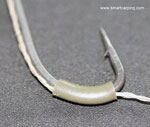 |
| Silicone set on the bend of the hook |
The majority of modern knotless-knot carp rigs are self setting, nearly all carp fishing rigs are “self re-setting”. What is self re-setting? Well, if you cast a carp rig out into the lake and the hook length lays in a heap on the bottom of the lake – or a fish has had the rig in its mouth and the rig has been ejected and it’s sitting all messed up – when you retrieve the rig it straightens itself out. So you have no chance to review it to hopefully understand how the rig was presented – unless the rig is tangled or knotted up and then it is obvious the rig is just not working. The only rig that will give a real indication of it being picked up and ejected is a knotless-knot with silicone on the hook shank to hold the hair in place. Although this is a standard rig it is the only rig that helps us understand when a rig has been ejected from a fish’s mouth and as such can be called a “Non Resetting Rig”.
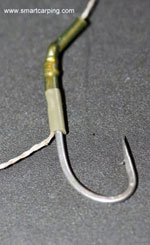 |
| Silicone now pushed back to the knotless knot indicating a rig being pick up and ejected |
See the two hook image photographs. The silicon was initially positioned on the bend of the hook with the hair trapped under the silicone. This forces the hair to leave in such a way as to make the hook turn over in the carp’s mouth a lot more aggressively which it does very well.
However it soon becomes apparent that once a carp has got the rig stuck in its mouth it can only suck and blow to attempt to reject the rig. The amount of force that the carp can exert as it blows the rig out if its mouth pushes the boilie, still attached to the hair, backwards, forcing the hair and the silicone back towards the knotless knot. The rig will stay in this position until you retrieve it and reset the rig manually. This is therefore a “NonResetting Rig” and, as such, gives an angler the opportunity to alter his rig, lead system or alarm/bobbin settings to be able to get a better bite to hook-up conversion ratio.
Once we are happy our hook set-ups are working correctly, we now need to look at our lead systems and back leads. We need to optimize these. The best lead system in terms of getting the most amount of indication is without doubt a running rig set up, using either a ring swivel lead or an inline lead without the plastic insert.
A running rig lead system uses the lead as an anchor so that whichever direction the fish may want to run, the lead will allow the line to run through the swivel or lead body, and in doing so, tension the line between the lead and the rod causing the bobbins to lift very effectively.
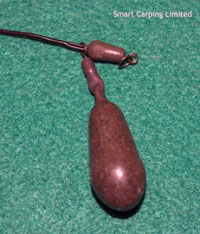 |
| A running rig lead system uses the lead as an anchor |
Using a running lead system works very well when you are considering using slack lines for the same reasons indicated above. With this in mind, all fixed and semi lead systems, lead clip, inline, helicopter or chod rigs can give us issues with bite detection, if we are not aware of the mechanics of the rig. With a fixed lead system, if a fish is hooked as it runs, it actually lifts the lead and carries it away with it as it swims off. If the fish runs away from you, the bobbin will lift as the line tensions. However if the fish swims towards you, without the line running into anything, you may never see the take unless you are fishing with heavy bobbins which will drop as you lose the tension on the mainline. If you fish with slack lines and with fixed or semi fixed leads you are putting yourself in a situation where you could be missing loads of bites.
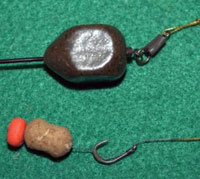 |
| Inline, helicopter or chod rigs can give us issues with bite detection |
Back leads can also cause us a few issues when it come to clear bite indication. By adding flying back leads or abseiling back leads to our main line, we are endeavouring to pin the line down to the lake bed to keep everything out of the way of the carp as they patrol in the swim. But if we have a back lead which is say, just 35 grams in weight on our line, and we also have a 50 gram bobbin plus a heavy stainless steel chain also attached to the line, when we do get a bite for the first few feet or inches of a take, depending upon the topography of the lake, the lightest weight on the line will lift first – and in this case it would be the back lead. This will dramatically reduce the indication on the bobbins and alarm. This would not be a problem if every bite was a full on screamer but on some really pressured waters the carp have learnt not to steam off if they are hooked, they simply stay very still shaking their heads and sucking and blowing in an attempt to shed the rig. In this situation you would not even spot the bite.
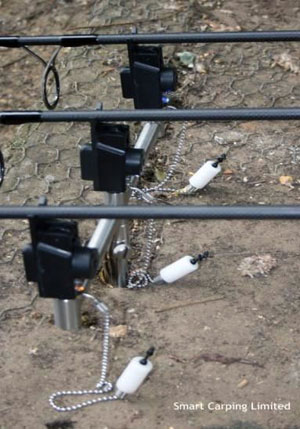 |
|
The bobbin weight needs to be right |
Now to optimise your bank side setup starting with bank stick and rod pods. I am happy to use either rod rest system as long as I can get my rods pointing directly towards where I am fishing. I want the line to come straight out of the rod towards the lead so the rod tip does not absorb any line movement and thus prevent the bobbins from moving and the alarms from sensing a take.
Individual sticks allow a far greater range of set-ups. They allow you to position your rods so you can fish to each corner of the swim but still aim the rods at where the lead is, to ensure you have got straight lines for best indications.
Once you have your bank stick positioned so the rods are pointing directly at your leads, make sure you position the rear sticks so the butt eye is positioned just before the alarm. This will ensure you get a very sharp V angle between the alarm , bobbin and first eye. This sharp angle will give lot a lot more bobbin lift for less line, pull giving far better indication.
The bobbin weight needs to be right for the range you are fishing at and the lead system you are using. For close in and margin fishing a light bobbin will work well. However if fishing at medium or long range then the bobbins need to be a lot heavier, or have the capability to have weights added to the bobbins. This extra weight will ensure if you get a line bite you can recognise it as such. A line bite occurs when the line tensions, as a fish brushes into the line, then as the line slips off the fish, the weight of the bobbin will bring the bobbin back to its starting position. The weight is the key here.
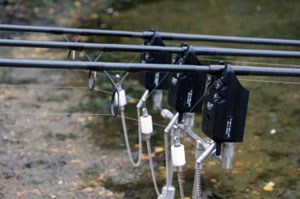 |
| Make sure you position the rear sticks so the butt ring is positioned just before the alarm |
As mentioned before, if the bobbin lifts and stays lifted, this could be a fish hooked but just sitting still trying to eject the rig. If we used a light bobbin you would never be able to discriminate between liners and takes in this scenario.
Finally, alarms: The more sensitivity adjustment you have on your alarms the better, as you are able to then tailor the alarm settings to suit the venue and the weather conditions you are fishing in. Try to obtain a setting that is as sensitive as possible without the alarm going off every couple of seconds whenever the line is tensioned by the lapping of the lake water or ducks swimming past, clipping the line.
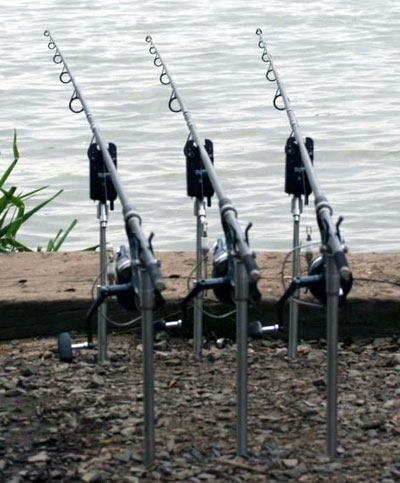 |
| Get your fishing set up tuned to the venue |
Get your fishing set-up tuned to the venue and conditions you are faced with and you will certainly bank more carp.
Ian Gemson – www.smartcarping.com










